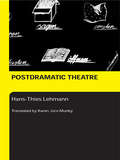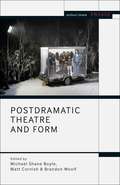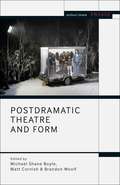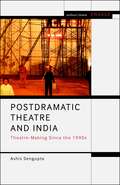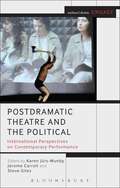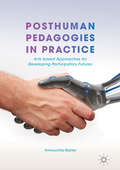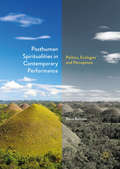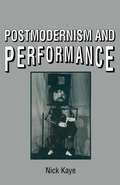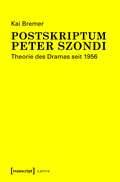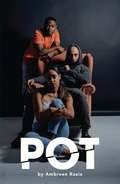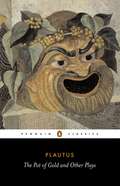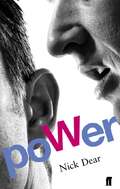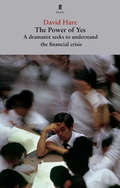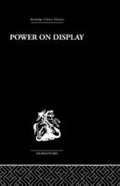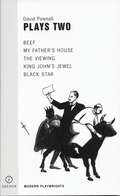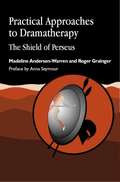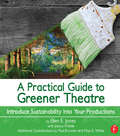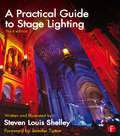- Table View
- List View
Postdramatic Theatre
by Hans-Thies LehmannNewly adapted for the Anglophone reader, this is an excellent translation of Hans-Thies Lehmann’s groundbreaking study of the new theatre forms that have developed since the late 1960s, which has become a key reference point in international discussions of contemporary theatre. In looking at the developments since the late 1960s, Lehmann considers them in relation to dramatic theory and theatre history, as an inventive response to the emergence of new technologies, and as an historical shift from a text-based culture to a new media age of image and sound. Engaging with theoreticians of 'drama' from Aristotle and Brecht, to Barthes and Schechner, the book analyzes the work of recent experimental theatre practitioners such as Robert Wilson, Tadeusz Kantor, Heiner Müller, the Wooster Group, Needcompany and Societas Raffaello Sanzio. Illustrated by a wealth of practical examples, and with an introduction by Karen Jürs-Munby providing useful theoretical and artistic contexts for the book, Postdramatic Theatre is an historical survey expertly combined with a unique theoretical approach which guides the reader through this new theatre landscape.
Postdramatic Theatre and Form (Methuen Drama Engage)
by Michael Shane Boyle Matt Cornish Brandon Woolf Enoch Brater Mark Taylor-BattyPostdramatic theatre is an essential category of performance that challenges classical elements of drama, including the centrality of plot and character. Tracking key developments in contemporary European and North American performance, this collection redirects ongoing debates about postdramatic theatre, turning attention to the overlooked issue on which they hinge: form. Contributors draw on literary studies, film studies and critical theory to reimagine the formal aspects of theatre, such as space, media and text. The volume expands how scholars think of theatrical form, insisting that formalist analysis can be useful for studying the ways theatre is produced and consumed, and how theatre makers engage with other forms like dance and visual art. Chapters focus on a range of interdisciplinary artists including Tadeusz Kantor, Ann Liv Young and Ryan Trecartin and Lizzie Fitch, as well as theatre's enmeshment within institutional formations like funding agencies, festivals, real estate and healthcare. A timely investigation of the aesthetic structures and material conditions of contemporary performance, this collection refines what we mean, and what we don't, when we speak of postdramatic theatre.
Postdramatic Theatre and Form (Methuen Drama Engage)
by Michael Shane Boyle Matt Cornish Brandon Woolf Enoch Brater Mark Taylor-BattyPostdramatic theatre is an essential category of performance that challenges classical elements of drama, including the centrality of plot and character. Tracking key developments in contemporary European and North American performance, this collection redirects ongoing debates about postdramatic theatre, turning attention to the overlooked issue on which they hinge: form. Contributors draw on literary studies, film studies and critical theory to reimagine the formal aspects of theatre, such as space, media and text. The volume expands how scholars think of theatrical form, insisting that formalist analysis can be useful for studying the ways theatre is produced and consumed, and how theatre makers engage with other forms like dance and visual art. Chapters focus on a range of interdisciplinary artists including Tadeusz Kantor, Ann Liv Young and Ryan Trecartin and Lizzie Fitch, as well as theatre's enmeshment within institutional formations like funding agencies, festivals, real estate and healthcare. A timely investigation of the aesthetic structures and material conditions of contemporary performance, this collection refines what we mean, and what we don't, when we speak of postdramatic theatre.
Postdramatic Theatre and India: Theatre-Making Since the 1990s (Methuen Drama Engage)
by Ashis SenguptaThis book revisits Hans-Thies Lehmann's theory of the postdramatic and participates in the ongoing debate on the theatre paradigm by placing contemporary Indian performance within it. None of the Indian theatre-makers under study built their works directly on the Euro-American model of postdramatic theatre, but many have used its vocabulary and apparatus in innovative, transnational ways. Their principal aim was to invigorate the language of Indian urban theatre, which had turned stale under the stronghold of realism inherited from colonial stage practice or prescriptive under the decolonizing drive of the 'theatre of roots' movement after independence. Emerging out of a set of different historical and cultural contexts, their productions have eventually expanded and diversified the postdramatic framework by crosspollinating it with regional performance forms. Theatre in India today includes devised performance, storytelling across forms, theatre solos, cross-media performance, theatre installations, scenographic theatre, theatre-as-event, reality theatre, and so on. The book balances theory, context and praxis, developing a new area of scholarship in Indian theatre. Interspersed throughout are Indian theatre-makers' clarification of their own practices vis-à-vis those in Europe and the US.
Postdramatic Theatre and India: Theatre-Making Since the 1990s (Methuen Drama Engage)
by Ashis SenguptaThis book revisits Hans-Thies Lehmann's theory of the postdramatic and participates in the ongoing debate on the theatre paradigm by placing contemporary Indian performance within it. None of the Indian theatre-makers under study built their works directly on the Euro-American model of postdramatic theatre, but many have used its vocabulary and apparatus in innovative, transnational ways. Their principal aim was to invigorate the language of Indian urban theatre, which had turned stale under the stronghold of realism inherited from colonial stage practice or prescriptive under the decolonizing drive of the 'theatre of roots' movement after independence. Emerging out of a set of different historical and cultural contexts, their productions have eventually expanded and diversified the postdramatic framework by crosspollinating it with regional performance forms. Theatre in India today includes devised performance, storytelling across forms, theatre solos, cross-media performance, theatre installations, scenographic theatre, theatre-as-event, reality theatre, and so on. The book balances theory, context and praxis, developing a new area of scholarship in Indian theatre. Interspersed throughout are Indian theatre-makers' clarification of their own practices vis-à-vis those in Europe and the US.
Postdramatic Theatre and the Political: International Perspectives on Contemporary Performance (Methuen Drama Engage)
by Karen Jürs-Munby Jerome Carroll Steve GilesIs postdramatic theatre political and if so how? How does it relate to Brecht's ideas of political theatre, for example? How can we account for the relationship between aesthetics and politics in new forms of theatre, playwriting, and performance?The chapters in this book discuss crucial aspects of the issues raised by the postdramatic turn in theatre in the late twentieth and early twenty-first century: the status of the audience and modes of spectatorship in postdramatic theatre; the political claims of postdramatic theatre; postdramatic theatre's ongoing relationship with the dramatic tradition; its dialectical qualities, or its eschewing of the dialectic; questions of representation and the real in theatre; the role of bodies, perception, appearance and theatricality in postdramatic theatre; as well as subjectivity and agency in postdramatic theatre, dance and performance.Offering analyses of a wide range of international performance examples, scholars in this volume engage with Hans-Thies Lehmann's theoretical positions both affirmatively and critically, relating them to other approaches by thinkers ranging from early theorists such as Brecht, Adorno and Benjamin, to contemporary thinkers such as Fischer-Lichte, Rancière and others
Postdramatic Theatre and the Political: International Perspectives on Contemporary Performance (Methuen Drama Engage)
by Karen Jürs-Munby Jerome Carroll Steve Giles Mark Taylor-Batty Enoch BraterIs postdramatic theatre political and if so how? How does it relate to Brecht's ideas of political theatre, for example? How can we account for the relationship between aesthetics and politics in new forms of theatre, playwriting, and performance?The chapters in this book discuss crucial aspects of the issues raised by the postdramatic turn in theatre in the late twentieth and early twenty-first century: the status of the audience and modes of spectatorship in postdramatic theatre; the political claims of postdramatic theatre; postdramatic theatre's ongoing relationship with the dramatic tradition; its dialectical qualities, or its eschewing of the dialectic; questions of representation and the real in theatre; the role of bodies, perception, appearance and theatricality in postdramatic theatre; as well as subjectivity and agency in postdramatic theatre, dance and performance.Offering analyses of a wide range of international performance examples, scholars in this volume engage with Hans-Thies Lehmann's theoretical positions both affirmatively and critically, relating them to other approaches by thinkers ranging from early theorists such as Brecht, Adorno and Benjamin, to contemporary thinkers such as Fischer-Lichte, Rancière and others
Posthuman Pedagogies in Practice: Arts based Approaches for Developing Participatory Futures
by Annouchka BayleyThis book investigates transdisciplinary, arts-based approaches to developing innovative and pertinent higher education pedagogy. Introducing timely critical thinking strategies, the author addresses some of the key issues facing educators today in an increasingly complex digital, technological and ecological world. The author combines emerging ideas in the New Materialism and Posthumanism schools of thought with arts-based teaching and learning, including Practice-as-Research, for Social Science contexts, thus exploring how this approach can be used to productively create new pedagogical strategies. Drawing on a rich repertoire of real-life examples, the volume suggests transferrable routes into practice that are suitable for lecturers, researchers and students. This practical and innovative volume will appeal to researchers and practitioners interested in Posthuman and New Materialist theories, and how these can be applied to the educational landscape in future.
Posthuman Pedagogies in Practice: Arts based Approaches for Developing Participatory Futures
by Annouchka BayleyThis book investigates transdisciplinary, arts-based approaches to developing innovative and pertinent higher education pedagogy. Introducing timely critical thinking strategies, the author addresses some of the key issues facing educators today in an increasingly complex digital, technological and ecological world. The author combines emerging ideas in the New Materialism and Posthumanism schools of thought with arts-based teaching and learning, including Practice-as-Research, for Social Science contexts, thus exploring how this approach can be used to productively create new pedagogical strategies. Drawing on a rich repertoire of real-life examples, the volume suggests transferrable routes into practice that are suitable for lecturers, researchers and students. This practical and innovative volume will appeal to researchers and practitioners interested in Posthuman and New Materialist theories, and how these can be applied to the educational landscape in future.
Posthuman Spiritualities in Contemporary Performance: Politics, Ecologies and Perceptions
by Silvia BattistaThis book provides an interpretative analysis of the notion of spirituality through the lens of contemporary performance and posthuman theories. The book examines five performance/artworks: The Artist is Present (2010) by Marina Abramović; The Deer Shelter Skyscape (2007) by James Turrell; CAT (1998) by Ansuman Biswas; Journey to the Lower World by Marcus Coates (2004); and the work with pollen by Wolfgang Laib. Through the analysis of these works the notion of spirituality is grounded in materiality and embodiment allowing the conceptual juxtaposition of spirit and matter to introduce the paradoxical as the guiding thread of the narrative of the book. Here, the human is interrogated and negotiated with/within a plurality of other living organisms, intangible existences and micro and macrocosmic ecologies. Silence, meditation, shamanic journeys, reciprocal gazing, restraint, and contemplation are analyzed as technologies used to manipulate perception and adventure into the multilayered condition of matter.
Posthuman Spiritualities in Contemporary Performance: Politics, Ecologies and Perceptions
by Silvia BattistaThis book provides an interpretative analysis of the notion of spirituality through the lens of contemporary performance and posthuman theories. The book examines five performance/artworks: The Artist is Present (2010) by Marina Abramović; The Deer Shelter Skyscape (2007) by James Turrell; CAT (1998) by Ansuman Biswas; Journey to the Lower World by Marcus Coates (2004); and the work with pollen by Wolfgang Laib. Through the analysis of these works the notion of spirituality is grounded in materiality and embodiment allowing the conceptual juxtaposition of spirit and matter to introduce the paradoxical as the guiding thread of the narrative of the book. Here, the human is interrogated and negotiated with/within a plurality of other living organisms, intangible existences and micro and macrocosmic ecologies. Silence, meditation, shamanic journeys, reciprocal gazing, restraint, and contemplation are analyzed as technologies used to manipulate perception and adventure into the multilayered condition of matter.
Postmodernism And Performance
by N. KayeThis book explores ways in which ideas and practices emerging in art, architecture and music have been taken up and developed in recent performance. Setting the notion of a postmodern style against a broader concept of the postmodern work, the study considers various forms of performance art, dance and theatre which define themselves in opposition to self-consciously modernist modes of work. In doing so, the book seeks to describe a position which opposes notions of the self-contained, autonomous art-work and may be understood in relation to concepts of the postmodern as it is defined in criticism, philosophy and cultural theory.
Postskriptum Peter Szondi: Theorie des Dramas seit 1956 (Lettre)
by Kai BremerWie verhält sich das Drama zu seiner potenziellen Inszenierung - und ist der Autor in ihm wirklich abwesend? Mit diesen Ausgangsfragen greift Kai Bremer Peter Szondis »Theorie des modernen Dramas« auf, die 1956 - im Todesjahr Brechts - erschienen ist. Historisch zeichnet die Studie die Dramatik seit Brecht nach, fokussiert die immer radikalere Episierung seit den 1970er Jahren und beleuchtet die Hinwendung zu älteren dramatischen Formen in den 1990er Jahren. Mit der Frage nach dem Stand des Tragischen und der Tragödie in der Gegenwart wird schließlich der Bogen zurück zu Peter Szondi geschlagen.
POT (Oberon Modern Plays)
by Ambreen Razia16-year-old Louisa wakes up on lockdown surrounded by debris from last night’s blow out. Josh has vanished but she's not alone and is beginning to feel the heat. She must decide whether or not to do the right thing, but time is running out and a series of revelations suggest everything is not as it seems.From the team who brought you The Diary of a Hounslow Girl. Writer Ambreen Razia returns with her second play, POT, exploring the landscape of Britain’s invisible children, adrift in the care system and inadvertently impacted by gang culture.
The Pot of Gold and Other Plays (Penguin Classics Series)
by PlautusOne of the supreme comic writers of the Roman world, Plautus (c.254-184 BC), skilfully adapted classic Greek comic models to the manners and customs of his day. This collection features a varied selection of his finest plays, from the light-hearted comedy Pseudolus, in which the lovesick Calidorus and his slave try to liberate his lover from her pimp, to the more subversive The Prisoners, which raises serious questions about the role of slavery. Also included are The Brothers Menaechmus, which formed the prototype for Shakespeare's The Comedy of Errors, and The Pot of Gold, whose old miser Euclio is a glorious study in avarice. Throughout, Plautus breathes new, brilliant life into classic comic types - including deceitful twins, scheming slaves, bitter old men and swaggering soldiers - creating an entertaining critique of Roman life and values.
Power
by Nick DearSome say power's an illusion. But Louis is the master of illusion. He has turned government into a spectacle, politics into a circus.Nick Dear's new play on the origins of the Sun King is a dark and dazzling tale of ambition, corruption and illusion. The play premiered at the Royal National Theatre in London, in June 2003.
The Power of Yes: A Dramatist Seeks to Understand the Financial Crisis
by David HareOn 15 September 2008, capitalism came to a grinding halt. As sub-prime mortgages and toxic securities continued to dominate the headlines well into 2009, this spring the National Theatre asked David Hare to write an urgent and immediate work to be staged this autumn that sought to find out what had happened, and why.Capitalism works when greed and fear are in the correct balance. This time they got out of balance. Too much greed, not enough fear. Meeting with many of the key players from the financial world, David Hare, author of The Permanent Way and Stuff Happens, has created The Power of Yes: a compelling narrative, as enlightening as it is entertaining.It's like a ship which you're being told is in apple-pie order, the decks are cleaned, the metal is burnished, the only thing nobody mentions, it's being driven at full speed towards an iceberg.Not so much a play as a jaw-dropping account of how, as the banks went bust, capitalism was replaced by a socialism that bailed out the rich alone.The Power of Yes opened at the National Theatre, London, in September 2009.
Power on Display: The Politics of Shakespeare's Genres (PDF)
by Leonard TennenhouseFirst published in 1986. 'Impressively open to the complexity of cultural discourses, to the ways in which one discursive form may function as a screen for another above all to the political entailment of genre. ' Stephen Greenblatt. What is the relation between literary and political power? How do the symbolic dimensions of social practice and the social dimensions of artistic practice relate to one another? Power on Display considers Shakespeare's progression from romantic comedies and history plays to tragedy and romance in the light of the general process of cultural change in the period.
Power on Display: The Politics of Shakespeare's Genres
by Leonard TennenhouseFirst published in 1986. 'Impressively open to the complexity of cultural discourses, to the ways in which one discursive form may function as a screen for another above all to the political entailment of genre. ' Stephen Greenblatt. What is the relation between literary and political power? How do the symbolic dimensions of social practice and the social dimensions of artistic practice relate to one another? Power on Display considers Shakespeare's progression from romantic comedies and history plays to tragedy and romance in the light of the general process of cultural change in the period.
Pownall: Plays Two (Modern Playwrights Ser.)
by David PownallIncludes the plays Beef, The Viewing, My Father’s House and Black StarBeef, a winner of the John Whiting Award, has so far only been published in radio form. In The Viewing a family buy a house which is haunted by God, while My Father’s House, commissioned by Birmingham Rep, looks at British politics through the eyes of Joseph Chamberlain and family. Black Star centres around the black American actor Ira Aldridge, touring in Shakespeare in Poland in 1865.
Practical Approaches to Dramatherapy: The Shield of Perseus
by Madeline Andersen-Warren Anna Seymour Roger GraingerPractical Approaches to Dramatherapy is derived from the authors' experiences of working with dramatherapy in a range of different situations. It focuses on the flexibility of the applications of dramatherapeutic principles. The book provides a comprehensive account of the history, theory and practice of drama and its therapeutic use. The authors explain the shape of a session, how dramatherapy works, and how it can be interpreted via myth, symbol and psychological theory. Work with individuals and groups is described, as are sessions with masks, improvisation, and use of scripts. The reader is encouraged to incorporate dramatherapy approaches into a variety of existing ways of working: for example, in socials skills groups, assertiveness training and anger management. Highlighting the potential scope of dramatherapy and providing practical examples and advice, Practical Approaches to Dramatherapy extends the boundaries of dramatherapy practice.
A Practical Guide to Greener Theatre: Introduce Sustainability Into Your Productions
by Ellen E. JonesProtecting the environment should be a priority of every theatrical production, but it can be challenging to mount an environmentally-friendly show with limited time, resources, and information. A Practical Guide to Greener Theatre: Introduce Sustainability Into Your Productions not only gives you the information you need to make greener decisions, but provides you with practical, workable solutions. You will learn how to assess and improve every production area – from costuming and painting, lighting and technical direction, to administrative offices and the rehearsal process. Checklists, examples of successful strategies, and step-by-step instructions will show you how to identify areas where manageable, sustainable changes can make your productions greener, and advice from working professionals, with experience greening their own productions, will leave you confident that your processes are environmentally sound. Even non-technical people who find themselves responsible for supervising productions will find green solutions that can be instituted with a staff of volunteers or students. Remember: every step toward sustainability is a step forward. Discover small fixes that will make your theatre productions greener. Examine ways to introduce greener practices in the design, execution, and strike process. Explore how introducing sustainability into your theatre productions can save your company time and money. Learn how sustainability and safety intersect to help protect your workers and volunteers.
A Practical Guide to Greener Theatre: Introduce Sustainability Into Your Productions
by Ellen E. JonesProtecting the environment should be a priority of every theatrical production, but it can be challenging to mount an environmentally-friendly show with limited time, resources, and information. A Practical Guide to Greener Theatre: Introduce Sustainability Into Your Productions not only gives you the information you need to make greener decisions, but provides you with practical, workable solutions. You will learn how to assess and improve every production area – from costuming and painting, lighting and technical direction, to administrative offices and the rehearsal process. Checklists, examples of successful strategies, and step-by-step instructions will show you how to identify areas where manageable, sustainable changes can make your productions greener, and advice from working professionals, with experience greening their own productions, will leave you confident that your processes are environmentally sound. Even non-technical people who find themselves responsible for supervising productions will find green solutions that can be instituted with a staff of volunteers or students. Remember: every step toward sustainability is a step forward. Discover small fixes that will make your theatre productions greener. Examine ways to introduce greener practices in the design, execution, and strike process. Explore how introducing sustainability into your theatre productions can save your company time and money. Learn how sustainability and safety intersect to help protect your workers and volunteers.
A Practical Guide to Stage Lighting
by Steven Louis ShelleyCombining theory and application, A Practical Guide to Stage Lighting provides a comprehensive analysis of lighting systems along with examples and illustrations of the technical tools and methods used in the industry. An entertaining and educational read, author Steven Louis Shelley draws from his 35+ years of diverse experience to explain how to get the job done along with real-life examples of projects from start to finish. Learn why some techniques are successful while others fail with 'Shelley's Notes' and 'Shelley's Soapbox,' all with a humor that guides you through complex problems and concepts. Highlights include:-Over 100 new topics, including analysis and application of the three categories of collaboration; a detailed examination of production meetings and one-on-one meetings; and meeting checklists with management and the creative team.-Over 50 new illustrations, including Shelley's Periodic Table of Fundamental Lighting Systems; groundplans, sections, and front elevations that illustrate basic system wash configurations for each direction of light. -Analysis, calculation, and step-by-step technical construction of each lighting system in the Hokey light plot.-Explanation of a manufacturer's cut sheet, and how to apply basic formulas to determine the beam size, footcandles, and gel transmission for lighting instruments.-Updated process of pre-programming computer lighting consoles prior to the load-in.-Comprehensive overview of archiving paperwork and softcopy for a production. Students and professionals will benefit from experience-based tips and techniques to prepare and execute a lighting design, along with learning how to avoid common traps.
A Practical Guide to Stage Lighting
by Steven Louis ShelleyCombining theory and application, A Practical Guide to Stage Lighting provides a comprehensive analysis of lighting systems along with examples and illustrations of the technical tools and methods used in the industry. An entertaining and educational read, author Steven Louis Shelley draws from his 35+ years of diverse experience to explain how to get the job done along with real-life examples of projects from start to finish. Learn why some techniques are successful while others fail with 'Shelley's Notes' and 'Shelley's Soapbox,' all with a humor that guides you through complex problems and concepts. Highlights include:-Over 100 new topics, including analysis and application of the three categories of collaboration; a detailed examination of production meetings and one-on-one meetings; and meeting checklists with management and the creative team.-Over 50 new illustrations, including Shelley's Periodic Table of Fundamental Lighting Systems; groundplans, sections, and front elevations that illustrate basic system wash configurations for each direction of light. -Analysis, calculation, and step-by-step technical construction of each lighting system in the Hokey light plot.-Explanation of a manufacturer's cut sheet, and how to apply basic formulas to determine the beam size, footcandles, and gel transmission for lighting instruments.-Updated process of pre-programming computer lighting consoles prior to the load-in.-Comprehensive overview of archiving paperwork and softcopy for a production. Students and professionals will benefit from experience-based tips and techniques to prepare and execute a lighting design, along with learning how to avoid common traps.
